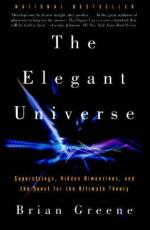
|
| Name: _________________________ | Period: ___________________ |
This quiz consists of 5 multiple choice and 5 short answer questions through Chapter 5, The Need for a New Theory, General Relativity vs. Quantum Mechanics.
Multiple Choice Questions
1. What is the photoelectric effect?
(a) Electrons follow quantum paths made by photons.
(b) Photons can spontaneously decay into electrons in powerful magnetic fields.
(c) When light shines on metals, the metals emit electrons.
(d) Electrons and photons only interact if they have the same frequency.
2. According to Newton's law of gravity, the strength of the pull between two objects depends on what factors?
(a) The distance between them and their average atomic numbers.
(b) Their masses and the distance between them.
(c) Their densities and the strength of the gravitational field they occupy.
(d) Their masses and potential energies.
3. Why are the fluctuations that quantum physics predicts not observable in everyday life?
(a) The fluctuations only occur in deep space.
(b) The human brain filters them out.
(c) Most fluctuations are canceled out by electromagnetic waves, like light.
(d) On large scales, the effects cancel each other out.
4. What type of a wave is light?
(a) An electromagnetic wave.
(b) A gravitational wave.
(c) A photonic wave.
(d) An electrical wave.
5. Which of the following is a correct statement, based on the theory of special relativity?
(a) Movement can only be measured relative to very massive objects, such as stars.
(b) Energy only exists relative to mass.
(c) Time and space are not experienced exactly the same by all observers
(d) Time is always the same to all observers, but space is not.
Short Answer Questions
1. If a clock were accelerated to nearly the speed of light for a year's time, which of the following would be true of its reading at the end of that time?
2. What would an outside observer notice about an object moving near the speed of light?
3. Einstein's equation, E=mc^2, states that which of the following are equivalent?
4. What does the quantum electroweak theory state about the two fundamental forces it describes?
5. Quantum physics began with the study of the energy inside a heated, closed container, such as an oven. The problem with theories at the time was that they predicted that _____.
|
This section contains 460 words (approx. 2 pages at 300 words per page) |

|




